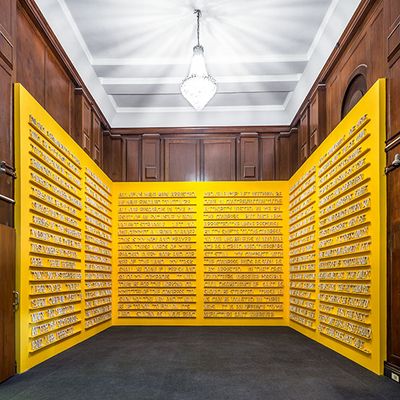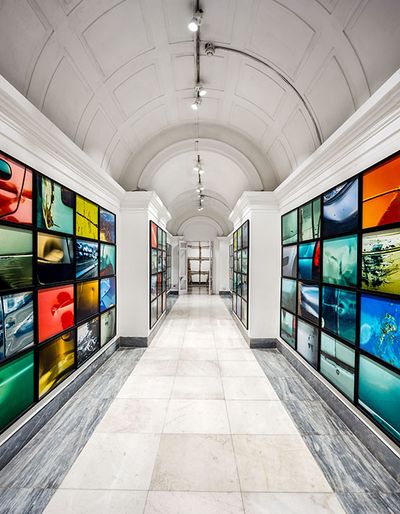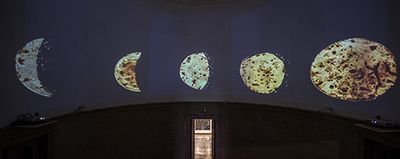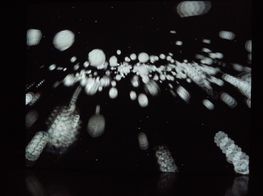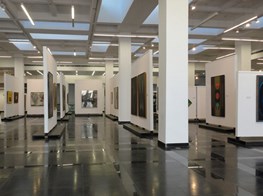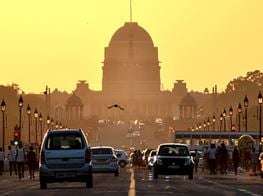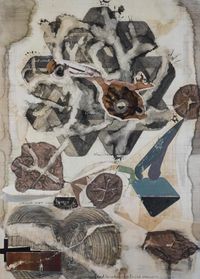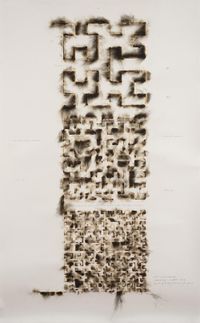Jitish Kallat: In Search of Fire
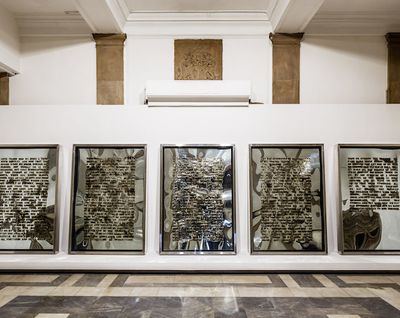
Jitish Kallat, Public Notice 1 (2003). Burnt adhesive on acrylic mirror, wood, stainless steel. 137 × 198 × 15 cm. Installation view: Here After Here, National Gallery of Modern Art, New Delhi (14 January–14 March 2017). Courtesy Gallery Nature Morte, New
On 14 January 2017, Jitish Kallat opened his mid-career retrospective at National Gallery of Modern Art (NGMA), New Delhi, under the curatorial supervision of Catherine David (the show ran to 14 March). Titled Here After Here, the exhibition brought together over 100 works—paintings, photographs, sculptural installations and videos—by Kallat, making this the largest survey of his practice thus far.
In collating the extremely diverse scales and imaginaries of Kallat's practice, David chose a non-linear approach, orchestrating the exhibition in what she calls 'a polyphony of artworks, juxtaposed to enable new readings and reveal hidden relationships'. Here After Here set up an open field across two galleries within NGMA's premises, where interactions between works were implicit, unanticipated and even contradictory.
In all, Here After Here encompassed a selection of works from Kallat's artistic career of the past two decades. Themes included the artist's continuous obsession with the urban landscape of Bombay (now Mumbai) and its people; his interest in iconic political speeches delivered throughout the history of the Indian subcontinent; and the extremely personal mapping of his familial past through the aesthetics of a cosmological imaginary.
The exhibition in the Jaipur House galleries began with one of Kallat's most iconic pieces, Public Notice 2 (2007), which re-stages a historical speech given by Mahatma Gandhi, considered the father of independent India, in the form of an installation of words crafted by what appears to be bones.
The speech was delivered on 11 March 1930, on the occasion of a protest against thesalt tax levied by the British who were ruling India at that time. 'Dandi March', as the event is popularly referred to, is considered a milestone for struggles that followed until the formation of the Indian nation-state in 1947.
In the early 2000s, Kallat revisited Gandhi's address during a time of intense rioting against the Muslim community, triggered by a 27 February 2002 fire attack on a Sabarmati Express Trainat Godhra, a site in the eastern state of Gujarat, India. Gandhi's iconic words of the 1930s, spoken only a few hundred kilometres from the area, were meant to induce a different imaginary of what an independent country might aspire to.
Kallat's interest in the re-invocation of such historic moments is also evident in Public Notice 1 (2003), a framed metal sheet cast with deeply cut letters, resembling foundation stones with burnt text, spelling out a speech given by the first prime minister of India, Jawaharlal Nehru, on the midnight of 15 August 1947, the eve of Indian Independence.
While navigating Kallat's interest in India's political past, Here After Here also expanded quite elaborately on his preoccupation with the urban space and the everyday. The Cry of the Gland (2010), for instance, is a series of photographs that represent portraits of shirt pockets filled with different kinds of everyday elements (papers, pens, currency notes and cards) mostly photographed inthe city of Mumbai.
Brought together in a massive photo-collage, these close-ups make reference to the extremely rapid and mobile lives of middle and lower middle class urban populations that inhabit the city.
Drawing on personal, historical and cosmological influences, Kallat's artistic interventions into past and present histories, both subtle and provocative, were articulated to great effect.
Exploring the urban dimension from another angle is 365 lives (2007), which documents different scratches and dents on automobiles. In the exhibition, the work was displayed in a long colonial-style hallway, creating the sense of passing through a busy street while offering a moment for viewers to focus on details they might normally ignore. Such works in this exhibition charted a vivid timeline of Mumbai, a city Kallat has both lived in and imagined through his work.
Kallat's practice has always had a peculiar take on monumentality, both literally and ironically shifting with ease across the historical, the personal and the everyday. This monumental quality took a particular life in Here After Here, which presented works that elevated the mundane in order to extend its reach beyond the realm of the ordinary. Epilogue (2010–11), which translates every moon the artist's father saw in his life, ran through the entrance of the second gallery (the NGMA's new wing).
Spread across 753 prints, the repeated circular forms of a roti, a type of Indian bread, mimic the lunar cycle. This mimicry appears again in Breath (2012), a multi-channel video installation projected onto the central dome of the building for this exhibition in a way that recalled a planetarium, with large-scale projections of the roti depicting the progression of a new moon as it becomes full.
Such a cosmological study is extended both spatially and conceptually in the Wind Study Series (2015–16), for which graphite on burnt adhesive studies create geometric shapes that emerge out of burnt impressions. These were presented next to a skeletal installation of an auto-rickshaw, Autosaurus Tripous (2007), a popular everyday commuting vehicle in urban India. Building on a similar aesthetic that Kallat adopted in Public Notice 2, the vehicle is constructed as a specimen made out of bones.
Similarly, another work at the very end of the exhibition linked back to both Public Notice 1 and Public Notice 2—Covering Letter (2012), an ambient installation for which a video is projected onto a fog screen. Theatrical in its aesthetic, the work is inspired by a personal letter Gandhi wrote to Adolf Hitler in 1939, a few weeks prior to the beginning of World War II, pleading with Hitler to reconsider his actions in light of the adverse impact they might have on the world.
The multiplicity of narratives and intensities that radiated from Kallat's practice in Here After Here created a sense of overlap with the current political landscape of India, recalling the historical voices of inspiration and dissent that once spoke of and for a nation at a time that is not dissimilar to the present day.
Drawing on personal, historical and cosmological influences, Kallat's artistic interventions into past and present histories, both subtle and provocative, were articulated to great effect. As a retrospective exhibition, in fact, an apt description of the artist's practice was somewhat summarised by the text presented in the work titled Burnt Text (2012):
'A man travels back in time to discover the cause of a famous fire. While in the building where the fire started he accidentally knocks over a kerosene lantern and causes a fire, the same fire that would inspire him years later to travel back in time.'
Here After Here positioned Kallat in the role of this man: as an artist who creates new fires while searching for similar ones in history. —[O]

